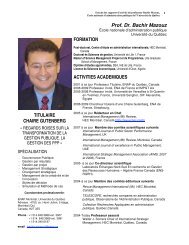Why do firms both make and buy? An investigation of concurrent ...
Why do firms both make and buy? An investigation of concurrent ...
Why do firms both make and buy? An investigation of concurrent ...
You also want an ePaper? Increase the reach of your titles
YUMPU automatically turns print PDFs into web optimized ePapers that Google loves.
302 A. Parmigiani<br />
Table 5. Multinomial logit models a<br />
Make<br />
vs. CS<br />
Model 5 Model 6<br />
Buy vs.<br />
CS<br />
Make vs.<br />
Buy<br />
Make vs.<br />
CS<br />
Buy vs.<br />
CS<br />
Make vs.<br />
Buy<br />
Asset specificity −0.089 −0.344 ∗∗∗ 0.255 ∗∗ −0.091 −0.349 ∗∗∗ 0.258 ∗∗<br />
(0.094) (0.120) (0.124) (0.94) (0.120) (0.122)<br />
Volume uncertainty −0.070 −0.115 0.045 −0.069 −0.109 0.041<br />
(0.083) (0.105) (0.109) (0.083) (0.104) (0.109)<br />
Technological uncertainty −0.113 ∗ −0.060 −0.053 −0.118 ∗ −0.069 −0.049<br />
(0.082) (0.131) (0.146) (0.083) (0.130) (0.145)<br />
Performance uncertainty 0.265 ∗∗ 0.017 0.249 ∗ 0.267 ∗∗ −0.002 0.269 ∗<br />
(0.123) (0.159) (0.182) (0.124) (0.161) (0.183)<br />
Firm scope economies 0.266 ∗∗∗ −0.253 ∗∗ 0.520 ∗∗∗ 0.259 ∗ 0.205 0.055<br />
(0.081) (0.111) (0.119) (0.201) (0.300) (0.351)<br />
Supplier scope economies −0.265 ∗∗∗ 0.431 ∗∗∗ −0.695 ∗∗∗ −0.291 ∗ 0.791 ∗∗∗ −1.083 ∗∗∗<br />
(0.088) (0.119) (0.131) (0.219) (0.264) (0.322)<br />
Firm × Supplier scope 0.003 −0.093 ∗ 0.096 ∗<br />
(0.043) (0.058) (0.068)<br />
Firm expertise 0.278 ∗∗∗ −1.095 ∗∗∗ 1.373 ∗∗∗ 0.772 ∗∗ −1.575 ∗∗∗ 2.346 ∗∗∗<br />
(0.110) (0.128) (0.148) (0.370) (0.527) (0.586)<br />
Supplier expertise −0.119 0.053 −0.171 0.682 −0.471 1.153 ∗∗<br />
(0.142) (0.171) (0.206) (0.584) (0.615) (0.695)<br />
Firm expertise × Supplier expertise −0.139 ∗ 0.119 −0.259 ∗∗<br />
(0.099) (0.129) (0.137)<br />
Firm age 0.009 ∗∗ 0.000 0.009 0.009 ∗∗ 0.000 0.009<br />
(0.005) (0.007) (0.008) (0.005) (0.007) (0.008)<br />
Firm size (employees) −0.010 −0.218 ∗ 0.207 ∗ −0.005 −0.229 ∗∗ 0.223 ∗<br />
(0.094) (0.133) (0.147) (0.095) (0.133) (0.147)<br />
Union −0.357 ∗ −0.567 ∗ 0.210 −0.379 ∗ −0.538 ∗ 0.159<br />
(0.260) (0.390) (0.448) (0.261) (0.393) (0.439)<br />
Powder metal −0.079 −0.356 0.277 −0.067 −0.334 0.267<br />
(0.247) (0.367) (0.409) (0.251) (0.373) (0.417)<br />
Scale economies −0.023 0.034 −0.057 −0.023 0.034 −0.057<br />
(0.066) (0.088) (0.113) (0.066) (0.089) (0.114)<br />
Volume required 0.064 0.248 ∗∗∗ −0.184 ∗∗ 0.056 0.257 ∗∗∗ −0.201 ∗∗<br />
(0.064) (0.099) (0.105) (0.065) (0.100) (0.105)<br />
Input similarity −0.059 −0.193 ∗∗ 0.134 ∗ −0.056 −0.193 ∗∗ 0.137 ∗<br />
(0.059) (0.086) (0.092) (0.058) (0.087) (0.093)<br />
Likelihood ratio 733.68(38) 738.70(42)<br />
Pseu<strong>do</strong> R 2 0.417 0.420<br />
Adjusted Count R 2 0.550 0.556<br />
χ 2 (−2 log likelihood) 0.000 (vs. controls) 0.040 (vs. Model 5)<br />
a CS, <strong>concurrent</strong> source; n = 805 for <strong>both</strong> models. A positive coefficient indicates that the first choice is more likely than the second.<br />
Parameter estimates for input controls <strong>and</strong> constants are omitted. Robust st<strong>and</strong>ard errors are in parentheses below the parameter<br />
estimates. All tests are one-tailed since the hypotheses are directional, with ∗ p





